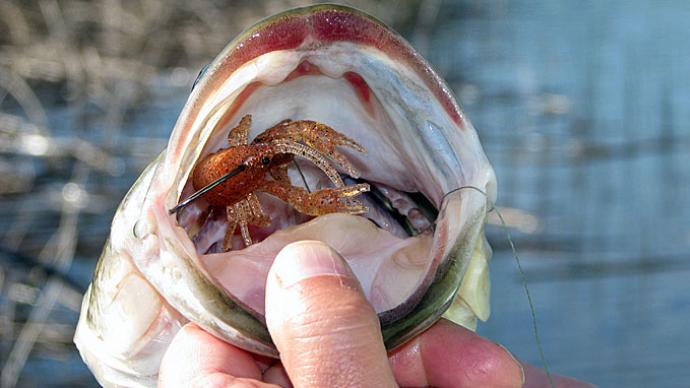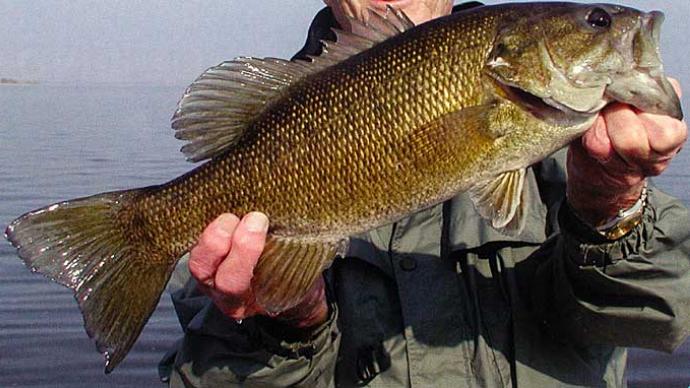Hey, folks, Glenn May here with BassResource.com. The air's starting to cool down a little bit after we've had the heat of the summer. The trees behind me are starting to change color. There's a little bit of crispness in the morning. Fall has arrived. I'm telling you what, it can be some of the best fishing that you have in the entire year if you hit it just right. The key is that you have to find the fish and follow 'em. Let me tell you a little bit about what I do throughout the fall to stay on top of the fish and how I catch 'em. Hopefully, you can incorporate that into your style of fishing.
The first thing you need to pay attention to is, in the fall, generally what happens is the bait fish will move shallow, up until the peak of the fall, and then they'll start to move back out. Of course, the bass will follow them, too. During the early transition period, late summer early fall, what I like to target is the points that are near shallow water. That may be near the entrance to a creek. That may be the entrance to a shallow bay or just the shallowere water on the lake.
This is true even if you're on the natural lakes that are up north where we don't have shad. I'm up north, too. We don't have too many shad. We do in the Columbia River, but pretty much nowhere else we don't have any. It'll happen with any bait fish that's in that lake. If the lake's predominantly perch or it's predominantly bluegill, again, they're gonna move shallow. They wanna feed up heavily in that fall and get ready for the winter time. Those points are what I target during the early transition period using deep-diving crankbaits and jigs.
As the fall progresses, they're gonna start moving shallower and they're gonna move further back up in those creeks or further up in the flats or further up in the shallower water. You need to follow them, too. You need to adjust your tactics again.
Again, you're gonna go a little bit lighter now on your baits. Instead of those deep-diving crankbaits, now use medium-diving crankbaits and even shallower diving crankbaits. Crankbaits and spinnerbaits and even topwater are excellent to throw this time of year. Those fish are keying on bait fish, so you want to use lures that mimic the bait fish.
Once you get toward the peak of the fall, shallow, shallow, shallow. That's where you want to be all the time, throwing spinnerbaits, throwing...what I like to throw here is these vibrating baits. This one here's a soft vibe from Savage Gear. Love these baits. These are excellent baits to throw. Again, see, that's a little bit of a shad color. I'm out here on the Columbia River. We have shad that are running right now. If I wasn't on the Columbia, they have an excellent perch pattern that I love to throw on my natural lakes that I have. Again, lakes don't necessarily have to have, be a big reservoir with all these creeks in them and stuff for this to happen. It'll happen on any body of water.
During the peak of the season, you're gonna be fishing the backs of the coves or the shallow flats up in the docks that are really shallow, the weeds, those type of things.
As the fall progresses and your water temperatures are dropping even more, you'll notice those weeds will start to look kind of wilted. They'll look a little brown. They'll look a little raggedy. What happens now is that they're starting to consume more oxygen than they are producing it. When that happens, that's gonna move the bait fish out to greener weeds a little bit deeper. So you want to follow and adjust your tactics there, too. Go a little bit deeper, a little bit deeper diving crankbaits. Take your soft vibes, run them across the top of those weeds. Get it hung up just a little bit and pop it loose. You're gonna snag it. When it pops loose out of those weeds, that's a lot of time when you get clobbered. I mean, you get hammered hard. Hold on to your rod and reel, because they're gonna rip it right out of your hands.
Also, you want to fish the outside of those weed lines. If you're in natural lakes, those weed lines that are formed by the milfoil, position your boat so you can cast along parallel to the edge of those weed lines in those 15 to 20 feet deep waters. Cast along with a deeper diving crankbait or slow roll a spinnerbait along there, and hang on, because those fish will dart out of those weeds and smack your lure.
As you get further closer to winter, the bite's gonna start to wane. It'll start to slow down. Those faster moving baits, they're not apt to hit them as much. That's when I flip over to using a jig or a tube bait. A tube bait can be a real sleeper bait this time of year because a tube mimics bait fish but it also mimics crawdads. Crawdads are protein-rich snacks that those bass love to eat. Perfect bait to be throwing closer to winter with those jigs.
As you get... One of the things I've noticed that has a tendency to happen in the late fall, is those fish, sometimes they'll just kind of mouth the jig. They'll grab them and they'll spit it out really quick. When that happens, that's when the tube bait shines. It's a little bit smaller profile and it's soft. When they bite onto it, they really don't feel that hardware that you have in a jig. They tend to hold onto it a little bit longer. It gives me a little bit more time to set the hook.
As for colors, fish white or shad color, any kind of white colored bait, white crankbaits, white spinnerbaits. If you're fishing a topwater bait, use a topwater that's got a white belly on it. White works really, really well. Even in lakes that don't have shad, the white still works really well. I don't know why, but it does. Even those other lakes, the natural lakes that don't have shad, use perch or bluegill patterns. You can clean house with that color.
One other thing to note about baits is this time of year in the fall, the bait fish are bigger. They're bigger than they were in the spring. They had all summer to grow, so throw bigger size baits. This is a half ounce bait I'm throwing here. Typically, I would throw a quarter ounce to three-eighth ounce baits during the rest of the year, but during this time of year, I throw bigger baits. I throw three-quarter ounce spinnerbaits, the big Zara Spooks. Heavy up, get the bigger baits, because that's what the fish are feeding on. Again, they're looking for a big meal to feed up for the winter time.
One other thing, if you catch a fish this time of year, don’t keep going down the bank and casting. Stop and go back, and fish that area. This time of year those fish will school up on areas. And if you go back and fish a spot where you caught a fish, you may end up catching a bunch more.
Another tip about finding the fish, is if you're going down the lake and you find birds, if they're sitting out in the middle of the lake or they're dive bombing bait fish, or sometimes you'll just see them stacked up on the shoreline, they're there for a reason. They want to eat too, okay? So they're not just gonna hang out any old place. They're gonna find some place where there's forage. If you see that happening, kick off the big motor and fish that area. You'd be surprised how many times you'll start picking up fish.
So those are the tips I have for you. I hope they help you find fish during the fall. If you get into them at the right time, you're gonna just slay 'em. You're gonna have a great, great time fishing them. If you have any more questions, please leave comments down below underneath. I read them. I try to answer them. You can also go to BassResource.com for all the tips and tricks. Also, for all the answers to all your bass fishing questions, go to BassResource.com.






